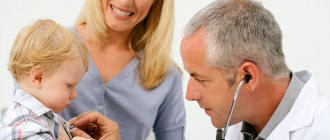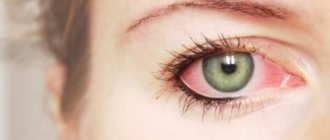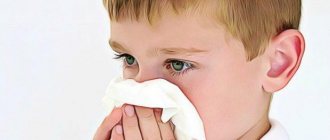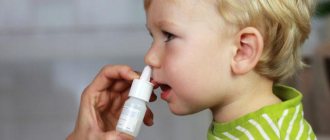Parents are often concerned about the question of why a child’s cough and rash appear without fever? According to the majority, such symptoms should be a consequence of high temperature, so they do not consider the condition to be serious.
A child's rash may look like vesicles, plaques, spots, pustules, papules and is the result of bacterial or viral infections. In terms of prevalence, an infectious rash in a baby is in 2nd place after an allergic rash. It may be accompanied by cough, diarrhea, and rhinitis.
Rash and cough in children without fever
A rash in a child that appears without fever is a consequence of the following ailments:
Heat rashes. Appears in infants due to tight wrapping, when the contents of the sweat glands are difficult to come out of. If the baby is properly cared for, the rashes rarely become inflamed and then quickly disappear; Allergies. The appearance of such a rash, which appears in all parts of the body, is caused by the body’s rejection of certain medications and foods. Under the influence of an allergen, the rash may intensify, and after it is neutralized, it may disappear. An accompanying symptom is itching. In children prone to allergies, a rash on the face and limbs sometimes occurs after an insect bite; symptoms include blisters and swelling.
Neurodermatitis. This disease affects up to 10% of children worldwide. The child experiences itching at night or when exposed to heat. Rashes in a child without fever are not necessarily harmless. Parents should be aware that this may require the help of a doctor. This is needed when:
- The rash is accompanied by throat discomfort and cough. A noticeable increase in body temperature;
- The rashes look like stars;
- When the rash is accompanied by vomiting;
- At normal temperatures, swelling occurs;
- When breathing is difficult.
- A child's rash and cough may have different, unrelated causes.
Parents should also know that before visiting a doctor, they should not lubricate pustules or other manifestations of a rash with any substances. Otherwise, it will be difficult to make a diagnosis.
Cough and rashes in children with fever
In children, infectious diseases occur differently than in adults. Respiratory pathology, such as a fever rash combined with a cough, should make parents think about visiting a doctor, and at the same time, about the causes of the symptoms.
Different diseases have many similar signs, and only a pediatrician can consider several causes at once.
A rash in combination with a cough and fever indicates the possibility of childhood infectious diseases.
When the rash occurs as a result of infection, parents are able to independently identify the cause of its appearance. But when the child has a fever, a cough and a nonspecific rash, this is not easy to do.
Rubella
Rubella is a common disease among children. This disease can be accompanied by a large number of negative symptoms, including rashes, runny nose, increased body temperature and coughing. With rubella, the rash is localized on the neck. Only a few days after its occurrence does it spread throughout the body. It most severely affects the folds. The spots are light pink in color. They are small, but can merge into large shapeless areas.
Rubella rashes are usually accompanied by elevated body temperature. Its indicators can increase to 39 degrees. However, in some cases it may remain normal. The little patient’s state of health remains almost unchanged. Lymph nodes enlarge in some areas. This disorder usually lasts for at least two weeks.
Cough with fever and rash may be caused by rubella
The disease usually appears several weeks after contact with the sick person. It is impossible to establish a diagnosis on your own. The rash with rubella is very similar to the rashes that appear with:
- scarlet fever;
- allergic reaction;
- prickly heat.
The disease occurs like a mild cold. As noted earlier, rubella is predominantly a childhood disease. However, recently it has also affected people under 30 years of age. The risk group includes pregnant women. A girl can transmit the disease to her baby in utero. This can cause fetal death or congenital pathologies.
Rubella can be transmitted from mother to child
In the early stages of pregnancy, a woman with rubella is recommended to give preference to artificial termination.
Adults are bothered by coughing when they have a rash
Rashes on different parts of the body in an adult appear in the most unexpected parts of the body. There are various explanations for this manifestation; it is not worth diagnosing them yourself, and to some extent it is even dangerous.
In an adult, a rash can occur from an infection or from a simple allergy. Most often the rash occurs on the head, lower and upper extremities.
The rash can have different sensations - it burns, itches, or does not show any symptoms at all.
When the rash is allergic in nature, it is usually accompanied by symptoms:
- Inflammation of the mucous membrane of the eyes;
- Runny nose;
- Cough and sneeze.
The causes of an allergic rash can be:
- Pharmaceuticals;
- Citrus fruits;
- Excess sweets;
- Plant pollen;
- Pet hair.
If an adult's rash itches, it may well be a symptom of an infectious disease. This diagnosis is confirmed by general malaise, fever, cough, and chills.
A rash in an adult sometimes occurs due to weakening of the immune system, which occurs with a sharp increase in physical stress on the body.
Just about health
Different diseases have different rashes
A rash that suddenly appears on a child’s body always causes great concern and caution among parents. After all, various skin rashes are often the first sign of childhood infectious diseases. Moreover, with different diseases, the rash has a completely different appearance and its own characteristic signs. Let's figure out what kind of rash occurs with various childhood infections.
Scarlet fever rash
With scarlet fever, the rash feels like sandpaper. Most of the rashes occur in the groin, armpits, and on the folds of the arms and legs; later the rash spreads to the stomach and chest. The rash is accompanied by high fever, headache and sore throat. At the same time, the tongue also has a characteristic appearance: it becomes dark crimson, and white papillae are clearly visible on it (“strawberry tongue”). The lymph nodes in the neck become swollen. The face turns red, only the nose and lip area (nasolabial triangle) remain pale.
Chickenpox rash
With chickenpox (chickenpox), the rash has typical stages of development: spot-tubercle-vesicle-crust. A spot with a diameter of 2–4 mm turns into a papule (tubercle) and vesicle (vesicle) within a few hours. The vesicles are filled with transparent contents, sometimes reach 6 mm in diameter, and are usually itchy and itchy. The number of rashes can be single, or can reach hundreds of elements! The rash covers the entire body, face, neck, legs and arms, excluding only the palms and soles; The scalp is especially “spotty.” It lasts from 2 to 10 days, “cleaning” the skin of crusts usually occurs after 5–10, but traces of chickenpox last much longer.
Measles rash
With measles, first (on the second or third day of illness) small whitish spots appear on the mucous membrane of the cheeks near the molars, surrounded by a narrow red border - Belsky-Filatov-Koplik spots, characteristic specifically for measles (in appearance they resemble semolina). At the same time, the temperature rises, the head hurts, a runny nose and a “barking” cough are observed. On the fourth or fifth day of illness, a rash appears: first on the face, neck, behind the ears, the next day on the torso, then on the bends of the arms and legs, including the fingers. The rash consists of small papules surrounded by a spot and prone to coalescence. The reverse development of the elements of the rash begins on the fourth day of the rash: the temperature returns to normal, the rash darkens, turns brown, becomes pigmented, and peels off (in the same sequence as the rash). Pigmentation lasts 1–1.5 weeks.
Rubella rash
With rubella, a rash appears as the first sign of the disease. Sometimes it is accompanied by a slight runny nose, low-grade fever, and mild redness in the throat, as with a normal ARVI. The rash associated with rubella is pale pink, round or oval in shape, 2–5 mm in diameter, in typical cases small-spotted or roseolous. Typically, the elements of the rash do not merge and do not rise above the surface of the skin. More often, the rashes begin on the face and neck, but after a few hours they spread throughout the body, condensing on the bends of the arms and legs, back and buttocks. There are few rashes on the face, and there are none at all on the palms and soles. The rash lasts 1–3 days, then turns pale and disappears, leaving no pigmentation or peeling behind.
Meningitis rash
>
With meningococcal meningitis, already in the first day, 80% of children develop a rash on the skin in the form of pink spots ranging in size from 0.5 to 2 cm - the so-called maculopapular rash. It begins to appear on the stomach, buttocks, heels, legs and spreads throughout the body in a matter of hours. After 2–3 hours, small hemorrhages appear in the center of the spots. In addition, there are other signs characteristic of the disease: severe headache, nausea, vomiting, muscle tension in the back of the head, etc. With a mild form of meningitis, the rash remains in the form of small pinpoint rashes of a dark cherry color for another 3-4 days. In more severe forms of meningitis, the rash consists of large spots and bruises; This rash goes away within 10 days.
Other rash
The most “not scary” rash is the so-called “sweating sweat”, which often appears in young children. This rash is located in those areas of the body where sweating is most active (in the folds of the neck and armpits, on the chest and back), it becomes brighter and more noticeable when overheated and quickly disappears when proper measures are taken. Areas of the body with heat rash should be washed more often, and the skin should be lubricated with baby cream, baby oil or baby powder. When bathing your baby, you can add an infusion of chamomile or chamomile flowers to your baby’s bath. The normal lifespan of such a rash is short - after a day it usually disappears completely. There are also different types of rashes associated with insect bites, certain skin conditions, or viral diseases such as herpes. Often, some kind of skin rash occurs as an allergic reaction to certain foods, medications, animal hair, etc. In this case, the mother needs to analyze whether she gave the baby any new foods or medications, whether the child had contact with cats or dogs, etc. Sometimes the rash is accompanied by itching, nasal congestion, watery eyes, and sneezing. In this case, the child will be helped by antihistamines and diet.
In any case, it is better to show a child with a rash to a doctor as soon as possible. After all, many diseases accompanied by a rash are contagious and can pose a threat to other children. www.prosto-zdorovie.ru
What to feed a sick child
Rickets: Vitamin D deficiency
The child has a fever. What to do?
Lactase deficiency. When milk is not a friend, but an enemy
Parents vs grandparents
Chickenpox: brought by the wind
False croup attacks at night
- an acute infectious disease characterized by fever, catarrhal symptoms of the upper respiratory tract (cough, runny nose, hoarseness), inflammation of the mucous membranes of the eyes, mouth and the appearance of a red, large-spotted rash on the skin. The causative agent of measles is a virus. Contained in small droplets of sputum, mucus and saliva of a patient, the virus enters the air when coughing, sneezing and talking and then penetrates through the respiratory tract into the body of a healthy child (airborne transmission of infection). Droplets of sputum, saliva and mucus containing the virus easily spread throughout the room and can penetrate with the air current into neighboring rooms and apartments through cracks and ventilation ducts. Almost all people are susceptible to measles; those who have recovered from the disease develop lasting, lifelong immunity. Infection occurs even with fleeting contact. More than half of the cases of K.'s diseases occur in children under 5 years of age. Children under 3 months. K. usually do not get sick, because they are given immunity to the disease from their mother, who had K. in childhood. Children born to mothers who have not had measles can get it before the age of 3 months.
There are four periods of illness. The first period - incubation (hidden) - lasts 6-18 days; during this time, the virus can be in the human body without causing any manifestations of the disease (see Incubation period. The second period is prodromal (initial, catarrhal), which occurs after the latent period, lasts 3-4 days. It is characterized by an increase in temperature, catarrhal symptoms (runny nose, cough, hoarseness of voice, redness of the eyes, lacrimation). Gradually, these phenomena intensify, photophobia, puffiness of the face, barking cough appear, and swelling of the larynx may develop - false croup. A characteristic sign of K. during this period is the appearance of tender, small white spots , surrounded by a red rim, on the mucous membrane of the cheeks against the lower molars (the so-called Filatov-Koplik spots; color table, art. 80, 6). They appear 2-3 days before the rash, disappearing on the 1st-2nd rash day.
Another characteristic sign of K. is the appearance of red spots on the mucous membrane of the soft and hard palate, the so-called. enanthema (color table, art. 80, 7). Quite often, children are irritable, they experience deterioration in sleep, appetite, frequent bowel movements, and stool becomes liquid. Older children may have headaches, vomiting, nosebleeds, and abdominal pain. The third period - rash - begins with a new rise in temperature, deterioration of the condition, and redness of the throat. On the 4th—6th day (from the onset of the disease), a characteristic red, large-spotted rash appears (color table, art. 80, 5.8). The rash first appears on the face - behind the ears, on the cheeks and on the forehead, and after a few hours it spreads over the entire face. Becoming more intense, the rash covers the torso on the 2nd day, and the limbs on the 3rd. The skin with K. is moist (due to increased sweating), and there is slight itching. The rash period lasts 3-4 days. The fourth period - pigmentation (recovery) - begins on the day the rash appears on the extremities. On the same day, the rash on the face begins to darken and turn into brown spots. Spreading from top to bottom, pigmentation lasts 7-10 days. The skin becomes dry, especially on the face, palms and soles; pityriasis-like peeling appears. The temperature gradually decreases, the general condition of the child improves.
The course of measles can be either mild or severe. A mild form of measles occurs more often in children 4-5 months old - all periods are shortened, the child’s condition worsens slightly; in children older than 6 months. a severe form of K is more often observed. Severe headache, persistent vomiting, nosebleeds are possible, and in some cases - delirium, hallucinations (see Mental illnesses). Complications: pneumonia, laryngeal edema, inflammation of the middle ear (otitis), intestinal disorders.
When the first signs of the disease appear, you must immediately call a doctor, who will decide whether to hospitalize or treat the child at home. In the treatment of K., general hygiene measures, diet, and care are of primary importance (see Caring for the sick, features of caring for a sick child). The patient should be in a well-ventilated area - it is necessary to ensure a constant flow of fresh air and a moderate temperature (17-18°). During the warm season, it is useful to take a sick child out into the fresh air or keep him near a constantly open window. Darkening the room is harmful; for photophobia, it is enough to place the patient with his back to the light source. It is necessary to care for the skin (wiping, washing), the mucous membrane of the mouth (drinking plenty of fluids, especially after eating, rinsing the mouth after eating) and eyes (rinse with cotton wool moistened with boiled water or 2% boric solution several times a day ). Frequent and abundant drinking is necessary.
Prevention. At the first signs of illness, the child must be isolated from other children.
As soon as K. is diagnosed, parents must immediately report this to the child care facility where the child is visiting. Many parents, believing that K.'s disease is almost inevitable, are often calm about the possible infection of the child. Meanwhile, K. is especially dangerous for children under 2 years of age, as well as for weakened children of other ages. Therefore, young and weakened children must be protected in every possible way from the disease K. Highly effective anti-measles vaccinations are of exceptional importance, which begin to be given to children at 10-12 months of age (see Preventive vaccinations).
In order to prevent the development of the disease in children who have not been vaccinated for any reason (contraindications, etc.) and who have been in contact with patients with K., gamma globulin is used. With timely administration of gamma globulin, the disease either does not develop or proceeds very easily (the so-called mitigated K.)
Sources: not yet!
The skin reflects the state of the body. Any changes should raise suspicion. If any redness, rashes or peeling appear, you should visit a specialist. The child has an unformed body. Children are most susceptible to various ailments. The child has a fever, cough and rash - symptoms that need treatment. They can occur for various reasons. In this case, the child may complain of weakness and a significant deterioration in health. The listed symptoms are pathogenic and always indicate the presence of a disease.
Immediate treatment of a child is required if a rash appears along with a cough and fever.
Other occurrences of rash and cough
Rashes in children can be caused by the well-known infectious disease rubella. In this case, there is a runny nose, discomfort in the throat, cough, redness of the mucous membrane of the eyes and throat. When rubella is affected, the spots are pale pink, small-pointed, and simultaneously affect the face, abdomen, chest, and limbs. It is accompanied by the appearance of a temperature of up to 37.2-37.50C, drowsiness, weakness, and headaches.
The rubella virus is dangerous for pregnant women; there is a risk of infection of the fetus.
Meningococcal infection is the most dangerous infectious disease for a baby and causes respiratory problems. There is a risk of meningitis, nasopharyngitis - a mild form of meningococcal infection.
Allergic rash
Many families are faced with manifestations of allergies in children in the form of a rash. But not everyone determines the reason for it, and they believe that poor ecology, poor nutrition and inadequate physical development are to blame for everything.
Children's allergies can be classified into:
- Food, when allergens are: eggs, nuts, cow's milk, soy;
- Seasonal, its causative agent is flowering plants;
A special type of allergy is to flowers. It is caused by pollen from self-pollinating plants.
This type causes cough and rash at the same time, affects the gastrointestinal tract, and worsens the general condition of the child.
The rash in children, urticaria, causes itching. This is the most common manifestation of allergies, the cause of which is: medications, synthetic clothing, food, household chemicals.
Signs of an allergic rash : pink color, slight bulge, uneven distribution over the body.
Allergic erythema can be caused not only by allergens. The disease is characterized by the fact that, regardless of the cause, the consequences (rashes) are the same. Symptoms are raised spots above the skin, which eventually merge with each other and spread throughout the body. The rash disappears after 6 days, but leaves a marbled pattern on the skin. What causes the erythema rash has not been precisely established; it is believed that the disease is spread by air.
Features of the course and treatment of scarlet fever
Scarlet fever is an infectious disease caused by streptococcus. The disease is accompanied by a sore throat, dry cough and rash. A sick person’s temperature rises and signs of general intoxication are observed, resulting from the activity of bacteria.
Signs and symptoms of scarlet fever
With scarlet fever, the temperature rises, and the body and mucous membranes become covered with a red rash. The tongue becomes grainy and takes on a characteristic crimson color.
In the old days, scarlet fever was a common cause of death. But with the advent of antibacterial drugs, the likelihood of deaths has decreased to a minimum. Now treatment of the disease takes no more than 2 weeks. Streptococcus is destroyed using drugs belonging to the penicillin group.
The most effective are protected penicillins combined with clavulanic acid. These include:
- Augmentin;
- Amoxiclav;
- Ecoclave;
- Panclave.
DrugPhotoPrice
| Augmentin | from 257 rub. |
| Amoxiclav | from 227 rub. |
| Ecoclave | from 242 rub. |
| Panclave | from 307 rub. |
To relieve severe signs of intoxication, a glucose solution is infused intravenously.
Atopic dermatitis with cough
Allergic childhood skin disease caused by toxins and allergens. Caused by a genetic predisposition to immunoglobulin E (an excess of it) for contact with allergens.
Cough with AD has a completely different origin and is not associated with the disease.
Measles
The modern generation of parents know nothing about measles, except that they have heard the name. Thanks to the vaccination system, the infection is remembered only in case of random outbreaks.
The disease virus affects the nasopharynx and the main symptom of the disease is rashes all over the body.
It is believed that after suffering the disease, lifelong immunity is acquired.
Chicken pox
Chickenpox, as this disease is commonly called, is successfully tolerated at an early age in 90% of people. It is characterized by a rise in temperature, red spots with a vesicle, a gradual increase in the number of which is accompanied by severe itching.
Chickenpox is caused by the herpes virus, which lives in every body, and it is believed that it is better to have it in childhood, and then have lifelong immunity against it.
Scarlet fever
An acute infectious disease characterized by a small rash, intoxication, fever and sore throat. The causative agent is considered to be group A streptococcus. Scarlet fever is transmitted by air or household contact.
What childhood diseases are accompanied by a rash on the body, cough, fever
Any signs of a child’s illness cause fear and anxiety among parents. It becomes especially scary when, in addition to the usual snot or cough, the child’s body becomes covered with a rash. If the temperature is not clearly visible, the mother may not remember about it for some time, then the rash gives the child a particularly painful appearance and does not allow her to forget about the problem for a minute.
Rashes
Infectious rashes
In nature, there are many viruses and bacteria that are causative agents of diseases that manifest themselves as a complex of symptoms, including cough and skin rashes. Diseases are contagious, with a wide radius of destruction, which is why their names are well known to everyone. Viral infections accompanied by rashes include:
- measles;
- rubella;
- chickenpox;
- sudden exanthema.
The peculiarity of the treatment of viral infections is that there is basically nothing to treat them with. In the vast majority of cases, medicine is powerless against viruses. The only exceptions are chickenpox and herpes, a type of chickenpox. Only against this virus was it possible to create a drug. The body will have to fight the rest on its own if you don’t get vaccinated in advance.
It should be noted! In childhood, these diseases are much easier to tolerate than in adults. Therefore, for adults who have not had chickenpox in childhood, for example, it is advisable to get vaccinated against it, because the form in which the disease will occur can be fatally severe.
Bacteria cause a number of other, no less well-known infections:
- scarlet fever;
- meningitis;
- typhoid fever.
It is wiser to save yourself from bacterial infections with the help of special drugs - antibiotics, which will overcome the pathogen in the shortest possible time.
Vaccine
Important! Vaccines are also available for many dangerous bacterial infections. It is unwise to risk the life of a child by refusing vaccinations, since some of them (infections) can turn a child into a disabled person or even take his life in a matter of hours.
Non-infectious rash
A rash not associated with external microbial pathogens may be a manifestation of an allergic reaction. Most often, the skin reacts this way to food or physical contact with an allergen. For example, you can often see red cheeks, buttocks, and the inner surface of the elbow joints after consuming sweets, citrus fruits, or protein foods.
Contact dermatitis can occur after the baby's skin has rubbed against fabric dyed with aggressive dyes, or if the baby has been wearing synthetic, non-breathable items.
In combination with a cough, an allergy to the detergents used to treat children's underwear is most likely to manifest itself.
Fragrances will cause a spasm of the respiratory tract or provoke irritation of the mucous membranes, which will cause a cough, and the skin will turn red from contact with the tissue on which the chemical remains, and a rash will form.
When a child suddenly develops a rash and cough that this is an allergic reaction, parents cannot always realize.
The most common food that causes a dry and irritating cough accompanied by a rash is honey.
With its sweetness and its constituent components, it irritates the mucous membranes of even adults; its complex composition of natural origin often becomes a provocateur of dermatitis.
Baby and honey
How to distinguish an allergy from an infection
The main differences between allergic reactions and infectious diseases are shown in the table below.
Differences between allergic and infectious diseases
SymptomViral or bacterial infectionAllergy
| Contact with a patient with infection | Yes | No |
| Chills, fever | Yes | No |
| Runny nose | Yes | Maybe |
| Cough | Yes | Maybe |
| General weakness | Yes | No |
| Loss of appetite | Yes | No |
| Diarrhea/indigestion | Maybe | Possible (for dairy products) |
Attention! If parents have noted an allergic reaction of a child to a certain product, you need to be careful with its use, since each subsequent reaction of the body to it can be much more pronounced than the previous one.
About possible diseases
An experienced doctor, having analyzed all the circumstances and primary symptoms, will be able to quickly make a diagnosis and prescribe treatment.
Allergic bronchitis
Damage to the mucous membranes of the lower respiratory tract occurs when inhaling air with impurities:
- tobacco smoke;
- dust;
- chemical vapors;
- flavor particles.
If a child breathes dirty air, the bronchi may become inflamed, resulting in allergic bronchitis. Bronchitis is not accompanied by a rash. However, if the child was given a medicine to which an allergic reaction occurred, it is likely that the symptoms of an allergic cough and rash will occur simultaneously.
Cough and worms
In the diagnosis of helminth damage to the human body, there are no signs that unambiguously determine the connection between the presence of worms in a person and cough.
Life-threatening rash
Rash and fever in a child
If redness on the skin looks like small hemorrhages, the child’s condition has deteriorated sharply, there is vomiting and high fever, you need to take the child to the hospital as soon as possible. These are typical symptoms of meningococcal infection - meningitis. According to medical statistics, it can only take a few hours from the onset of symptoms to death.









